  NATIONAL
PARKS OF INDIA NATIONAL
PARKS OF INDIA
The
climatic and topographic diversity of India is reflected in
the flora and fauna of the country. Nowhere one can enjoy
this diversity more intensive and convenient than in the
variety of national parks. On foot, elephant back, cycle or
Jeep one can observe tigers, deer, elephants, rhinos or
different kinds of birds in their natural habitat. The parks
are well developed and one can find adequate accommodation
in lodges inside the parks or in close vicinity.
- BANDHAVGARH
NATIONAL PARK:
-
- Bandhavgarh is tucked
away in the hilly northeast of Madhya Pradesh and
is well accessible from Khajuraho. With 453 km2
it is an impressive park. It has the highest
density of tigers of any reserve in India and is
distinguished as the discovering land of the
famous white tiger of Rewa. It relishes of dry
deciduous vegetation, with sal forests. Apart from
preserving the maximum number of India's tigers,
it is densely populated with other animal species
too. The prime group of the mammal community
includes of langurs and rhesus macaque. The jackal,
bangal fox, bears, mongoose, hyena, jungle cat,
leopard and tiger are the other prominent members.
On the other hand, commonly viewable animals are
wild pig, spotted deer, sambar, dhole, the small
Indian civet, palm squirrel and lesser bandicoot
rat. The national park also has 250 species of
birds. November to June is the best time to
visit.
BHARATPUR
BIRD SANCTUARY (KEOLADEO GHANA NATIONAL PARK):
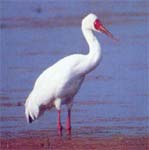  The
Keoladeo-Ghana-National Park is an area of 28 km2
of wetlands and is India's most famous bird sanctuary.
More than 350 different species of birds can be seen
here.
During the winter months, hundreds of thousands of
indigenous and migratory birds from far away places such
as China and Siberia congregate on land flooded in the
late nineteenth century by the local maharaja to create
a giant hunting reserve. Moreover you are almost certain
to glimpse several species of large mammals such as
black buck and deer, as well as lizards and pythons. The
park is best visited by bicycle or on foot. Bharatpur is
easy and fast accessible from Agra or Delhi. The best time to
visit is August to March. The
Keoladeo-Ghana-National Park is an area of 28 km2
of wetlands and is India's most famous bird sanctuary.
More than 350 different species of birds can be seen
here.
During the winter months, hundreds of thousands of
indigenous and migratory birds from far away places such
as China and Siberia congregate on land flooded in the
late nineteenth century by the local maharaja to create
a giant hunting reserve. Moreover you are almost certain
to glimpse several species of large mammals such as
black buck and deer, as well as lizards and pythons. The
park is best visited by bicycle or on foot. Bharatpur is
easy and fast accessible from Agra or Delhi. The best time to
visit is August to March.
-
-
BHITARKANIKA WILDLIFE
SANCTUARY:
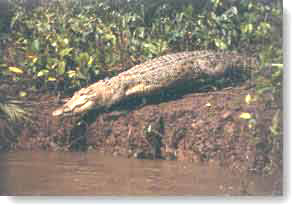 Bhitarkanika
is situated in the Brahmani - Baitarani
Delta at the Bay of Bengal in the Indian state of Orissa.
This area of mangrove forests and tidal waters was
proclaimed a sanctuary mainly to protect the nesting
habitat of more than 300.000 olive ridley marine turtles.
It is a fascinating event to see the procession of
thousands of these turtles, which can be observe from November
to April. It is also the home of the saltwater crocodile.
In addition one can find a lot of migratory birds during
the winter months. This also the best time to visit the
park. The park can be reached from Calcutta and
Bhubaneshwar. Bhitarkanika
is situated in the Brahmani - Baitarani
Delta at the Bay of Bengal in the Indian state of Orissa.
This area of mangrove forests and tidal waters was
proclaimed a sanctuary mainly to protect the nesting
habitat of more than 300.000 olive ridley marine turtles.
It is a fascinating event to see the procession of
thousands of these turtles, which can be observe from November
to April. It is also the home of the saltwater crocodile.
In addition one can find a lot of migratory birds during
the winter months. This also the best time to visit the
park. The park can be reached from Calcutta and
Bhubaneshwar.
CORBETT
NATIONAL PARK:
The Park lies in Uttar
Pradesh at the foothills of the Himalayas and is one of the
most renowned national parks in India. This historical place
was the center of
launch of the Project Tiger. With untainted glory and
natural splendor, Jim
Corbett National Park boasts of a great adventure. It has a
wide spectrum of diverse wildlife. Tigers, Leopards and
elephants can be observed from watchtowers. Anglers can find
an idyllic place at the banks of Ramganga River. The lush green
forests, riverine
vistas,
scenic beauty, pleasant climate and excellent facilities sum
to prize this national park as one of the best in India. It
can be accessed from Delhi and the best time to visit is
from November to May.
- GIR
NATIONAL PARK:
The park lies in
Gujarat in the West of India and is the last refuge of
the remaining Asian Lions (approx. 250 animals). The
many waterholes are an ideal place to spot some of the
many wild animals. Season is from October to May.
JAISAMAND WILDLIFE SANCTUARY:
This sanctuary of 160 km2 is in Rajasthan and was
created in 1957 around a lake of the same name. Here one can
find sloth bears, leopards, chital, wild boar as well as
many birds. Crocodiles, too, one can observe in their
natural habitat. The best time to visit is from November to
January.
KANHA
NATIONAL PARK:
One of the most beautiful and scenic wildlife sanctuaries of
Asia, Kanha National Park in Madhya Pradesh is responsible for
preserving numerous animal species. This national park has
bolstered the objectives of the Project Tiger. Situated in a
beautiful horse-shaped valley, the park has sal forests and
vast grasslands. The increasing habitat of the forest includes 22 mammal
species like monkeys and apes, hyena, wild pigs, deer and
black bucks. The Indian jackal, jungle cat, leopard, blue
bull are also spotted. It also has 200 species of birds.
Season is from November to June. KAZIRANGA
NATIONAL PARK:
 The
Kaziranga Park lies in the fertile planes of the
Brahmaputra River at the foothills of the Himalayas in
Assam. It is famous as the last major home for the
one-horned rhino. The rare animals are fast and agile
and can reach a height of 2 m. The park also has wild
gaur, deer, elephants, tigers, bears and many birds.
Park is open from November to June. The
Kaziranga Park lies in the fertile planes of the
Brahmaputra River at the foothills of the Himalayas in
Assam. It is famous as the last major home for the
one-horned rhino. The rare animals are fast and agile
and can reach a height of 2 m. The park also has wild
gaur, deer, elephants, tigers, bears and many birds.
Park is open from November to June.
MUDUMALAI
NATIONAL PARK:
This NP is in the foothills of the Nilgiris in Tamil
Nadu and with 321 km2
it is part of a much larger reserve (3000 km2)
which includes Bandipur and Wynad in neighbouring
Karnataka and Kerala. In Mudumalai, which means Old Hill
in Tamil, the mostly dense forest is home to chital (spotted
deer), gaur (Indian bison), tiger, panther, wild boar
and sloth bear. Otters and crocodiles inhabit the Moyar
River. The park's wild elephant population is one of the
largest in the country. Best time to visit February to
June.
NAGARHOLE
NATIONAL PARK:
Nagarhole ("Snake River") lies in Karnataka in the South of
India. It is a
hilly park with dense forest - thick jungle with a 30 m high
canopy - and is best explored by boat, Jeep or on the
back of an elephant. The park is home to the tiger,
elephant, panther, sloth bear, bison, barking deer,
sambar and a variety of birds Nagarhole is close to
tourist spots such as Mysore, Belur, Halebid or Ooty and
the best time to visit is October to April.
PERIYAR
NATIONAL PARK:
The exotic and
extensive park is in the state of Kerala. A rich flora and fauna
has spread around Lake Periyar and the slopes of the
Cardamom hills. It has a big elephant population as well as
sambar, wild pig, Malaba flying squirrel, gaur,
stripe-necked mongoose and many birds. Tigers and leopards
can also be found here, but are rarely spotted. The park is
best explored by boat. Park is open from September to May.
RANTHAMBORE
NATIONAL PARK:
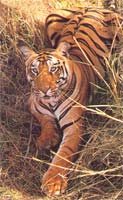 This
park of 400 km2
is a crown in the Indian wildlife panorama. The
Ranthambore National Park is renowned for its abundant
population of tigers. It has developed
ideally under the Project Tiger to preserve this royal
creature. The other inhabitants of the sanctuary include
marsh crocodiles, hyenas, jungle cats, chital, nilgai, chinkara and
sloth bears as well as 264 different species of birds. The enchanting flora and fauna along with the
easy visibility of tigers makes this sanctuary a
popular destination particularly for professional photographers. This
park of 400 km2
is a crown in the Indian wildlife panorama. The
Ranthambore National Park is renowned for its abundant
population of tigers. It has developed
ideally under the Project Tiger to preserve this royal
creature. The other inhabitants of the sanctuary include
marsh crocodiles, hyenas, jungle cats, chital, nilgai, chinkara and
sloth bears as well as 264 different species of birds. The enchanting flora and fauna along with the
easy visibility of tigers makes this sanctuary a
popular destination particularly for professional photographers.
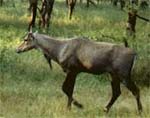 A
system of lakes and rivers is hemmed in by steep high
crags and, on top of one of these, is the extensive and
well-preserved fortress of Ranthambore, built in the
10th century. The fort is an additional attraction of
the park and there are superb views over the entire
region from the ramparts. The park is open from October
to June and is easily accessible from Jaipur (Rajasthan). A
system of lakes and rivers is hemmed in by steep high
crags and, on top of one of these, is the extensive and
well-preserved fortress of Ranthambore, built in the
10th century. The fort is an additional attraction of
the park and there are superb views over the entire
region from the ramparts. The park is open from October
to June and is easily accessible from Jaipur (Rajasthan).
-
SARISKA
NATIONAL PARK:
 The
beautiful Sariska Tiger Reserve and National Park near
Alwar (Rajasthan) is a former maharaja's hunting ground
and was declared a wildlife sanctuary in 1958. The
beautiful Sariska Tiger Reserve and National Park near
Alwar (Rajasthan) is a former maharaja's hunting ground
and was declared a wildlife sanctuary in 1958.  It
is managed since 1979 by Project Tiger. The sanctuary
encompasses abundant woodland dotted with evocating
ruins, including a popular Hanuman temple and an old
fort. Wildlife here includes leopard, panther, hyena, jungle
cat, civet, sambar, chinkara, four horned antelope, porcupine,
nilgai, chital, wild boar, mongooses, monkeys, peacocks,
parrots and other birds. The best prospect of seeing a
tiger is around the artificial water holes that have
been placed along the main road through the park to
attract animals in the dry season. Best time to visit is
from November to March. It
is managed since 1979 by Project Tiger. The sanctuary
encompasses abundant woodland dotted with evocating
ruins, including a popular Hanuman temple and an old
fort. Wildlife here includes leopard, panther, hyena, jungle
cat, civet, sambar, chinkara, four horned antelope, porcupine,
nilgai, chital, wild boar, mongooses, monkeys, peacocks,
parrots and other birds. The best prospect of seeing a
tiger is around the artificial water holes that have
been placed along the main road through the park to
attract animals in the dry season. Best time to visit is
from November to March.
-
- SIMLIPAL
NATIONAL PARK:
Simlipal National Park is located in the centre of
Mayurbhanj district in the Northeast of Orissa. With its
area of 846 km2 it is the core part of the
much bigger Tiger Reserve, which is under Project Tiger and
spreads over an areas of 2750 km2. It is home to
panthers, tigers, gaur, bison, antelopes, sambar, mouse deer
- the tiniest of the deer family, mugger or crocodiles, and
more than 223 species of birds. The glory of the park is
increased by the water falls, tribal settlements and
mountain peaks. The park is open for visitors from November
to June and can be
reached from Calcutta and Bhubaneshwar.
- SUNDERBANS TIGER
AND BIOSPHERE RESERVE:
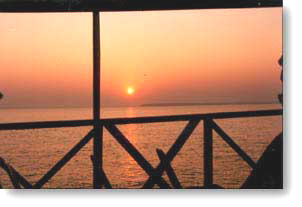 Located
in the Ganga delta in West Bengal, spanning the Hooghly
in the west and Teulia river in the east, Sunderbans was
declared a National Park in 1984. The park covers a vast
stretch of mangrove swamp, lush forested islands and
small rivers near the Bay of Bengal. Most of the region
comprises estuarine mangrove forests and swamps which
supports an ecosystem specially adapted to great
salinity. Sunderbans is home to the magnificent Royal
Bengal tiger, the park holding more tigers than any
other tiger reserve. More than 400 tigers were recorded
during the mid-1980s. Project tiger has also launched a
programme to protect the Olive Ridley sea turtles.
Crocodiles and the gangetic dolphin are to be found
aplenty in the Raimgangal river. The Sajnakhali
sanctuary, famous for its rich avian population, is
regarded as a part of the Sunderbans National Park. The
best time to visit is September
to May. Located
in the Ganga delta in West Bengal, spanning the Hooghly
in the west and Teulia river in the east, Sunderbans was
declared a National Park in 1984. The park covers a vast
stretch of mangrove swamp, lush forested islands and
small rivers near the Bay of Bengal. Most of the region
comprises estuarine mangrove forests and swamps which
supports an ecosystem specially adapted to great
salinity. Sunderbans is home to the magnificent Royal
Bengal tiger, the park holding more tigers than any
other tiger reserve. More than 400 tigers were recorded
during the mid-1980s. Project tiger has also launched a
programme to protect the Olive Ridley sea turtles.
Crocodiles and the gangetic dolphin are to be found
aplenty in the Raimgangal river. The Sajnakhali
sanctuary, famous for its rich avian population, is
regarded as a part of the Sunderbans National Park. The
best time to visit is September
to May.
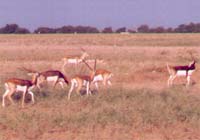
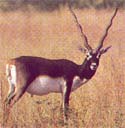 This
sanctuary is an 820 hectares large, salty area 12 km from Sujangarh
and 170 km from Bikaner on the road from Bikaner to
Jaipur in Rajasthan. Here one can see about 400 black bucks
- antelopes which are threatened by extinction - before the
backdrop of heat-induced mirage. This was originally a game
park of the Maharaja of Bikaner before it was declared a
sanctuary. In is interesting to see how the males command
over their harems and how these animals look after their
offspring. This
sanctuary is an 820 hectares large, salty area 12 km from Sujangarh
and 170 km from Bikaner on the road from Bikaner to
Jaipur in Rajasthan. Here one can see about 400 black bucks
- antelopes which are threatened by extinction - before the
backdrop of heat-induced mirage. This was originally a game
park of the Maharaja of Bikaner before it was declared a
sanctuary. In is interesting to see how the males command
over their harems and how these animals look after their
offspring.
VAN VIHAR,
RAMNAGAR SANCTUARY:
The breathtaking beauty of this sanctuary stretches over
an area of 60 km2. It lies in Rajasthan and is
divided into two parts Van Vihar and Ramsagar. Van Vihar on
the Vindhyan Plateau supports a rather light grow of
crippled Dhok- and Khair trees, where as Ramsagar is
situated around the picturesque Lake Ramsagar. Wildlife here includes
sambar, chital, wild boar, sloth bear, hyena, leopards, as
well as crocodiles, birds and a variety of snakes and fish
in and around Lake Ramsagar.
VAN VIHAR,
DARRAH SANCTUARY:
- The former hunting ground of the Kota Maharajas in
Rajasthan was declared a sanctuary in 1955 and covers an
area of about 266 km2 of land. The
hilly area with its dense jungle is worth a visit. Here
one can find wolves, sloth bear and leopards. The best
time for a visit is from February to May.
VAN VIHAR, MT.
ABU SANCTUARY:
- The
highest point of the Aravallis range in Rajasthan, the
Guru Shikhar, lies within this 289 km 2 large
sanctuary. It was declared a sanctuary 1960 and is
amongst others the home for sambar, wild pigs and
leopards.
DESERT NATIONAL
PARK: The
large desert and sand areas around Jaisalmer were declared
a desert national park. For the layman it may appear there
is not much to be prodected in a desert. But the desert is
a very sensitive ecological system, with an extraordinary
multiplicity of animal species, of which some are
threatened by extinction.
The desert national park is The
large desert and sand areas around Jaisalmer were declared
a desert national park. For the layman it may appear there
is not much to be prodected in a desert. But the desert is
a very sensitive ecological system, with an extraordinary
multiplicity of animal species, of which some are
threatened by extinction.
The desert national park is 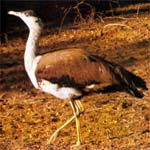 an
excellent example of the ecological system of the Thar
desert with its fauna. Sand dunes form about 20% of the
park, but the largest part of the land consists of cracked
rocks, hard salt crusts of former lakes, water holes and
dunes. Here
live chinkara antelopes and black buck antelopes, which
can move with great speed in the barren land. One can also
find wolves, desert fox, desert cat, birds and reptiles.
18 km from Jaisalmer lies the Akal Wood Fossils Park,
where one can see fossils of tree trunks and shells which
are about 180 billion years old. an
excellent example of the ecological system of the Thar
desert with its fauna. Sand dunes form about 20% of the
park, but the largest part of the land consists of cracked
rocks, hard salt crusts of former lakes, water holes and
dunes. Here
live chinkara antelopes and black buck antelopes, which
can move with great speed in the barren land. One can also
find wolves, desert fox, desert cat, birds and reptiles.
18 km from Jaisalmer lies the Akal Wood Fossils Park,
where one can see fossils of tree trunks and shells which
are about 180 billion years old.
|
![]()
